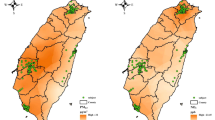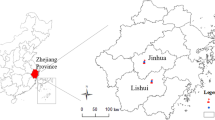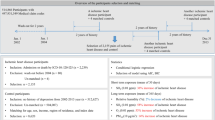Abstract
Background
Evidence of the acute effects of high-level air pollution on small airway function and systemic inflammation in adults is scarce.
Objective
To examined the associations of short-term (i.e., daily) exposure to multiple air pollutants with lung function and inflammatory markers.
Methods
We assessed short-term (daily) effects of air pollutants, including particulate matter with aerodynamic diameter less than 2.5 μm (PM2.5) and 10 μm (PM10), nitrogen dioxide (NO2), sulfur dioxide (SO2) and carbon monoxide (CO), on lung function and peripheral immune cell counts over various lag times using generalized linear regression models.
Results
A total of 4764 adults were included from the general community-dwelling population in Shanghai, China. Exposure to air pollutants and lung function were negatively correlated. Decline in FEF between 25% and 75% of vital capacity (FEF25–75%) were found associated with PM2.5, SO2, and CO, and decline in forced expiratory volume in 3 s (FEV3) to forced vital capacity (FVC) ratio were associated with all examined pollutants, indicating obstruction in small airways. Obstructed airflow in large and middle airways as indicated by decline in FEV1/FVC were also associated with all pollutants. In subgroup analysis, significant negative associations between the five pollutants and SAD parameters were found only in males but not in females. The difference in the associations of SO2 with FEF75% between males and females achieved statistical significance. Additionally, all examined pollutants were significantly associated with lower peripheral neutrophil count.
Impact statement
-
Acute exposure to air pollutants were associated with airflow-limitation.
-
Both small airways and proximal airways were affected.
-
Acute exposure to air pollutants were accompanied with a lower neutrophil count.

This is a preview of subscription content, access via your institution
Access options
Subscribe to this journal
Receive 6 print issues and online access
$259.00 per year
only $43.17 per issue
Buy this article
- Purchase on Springer Link
- Instant access to full article PDF
Prices may be subject to local taxes which are calculated during checkout





Similar content being viewed by others
Data availability
The datasets used and analyzed during the current study are available from the corresponding author on reasonable request.
References
Macklem PT. The physiology of small airways. Am J Respir Crit Care Med. 1998;157:S181–3.
Usmani OS, Singh D, Spinola M, Bizzi A, Barnes PJ. The prevalence of small airways disease in adult asthma: A systematic literature review. Respir Med. 2016;116:19–27.
Boeck L, Gensmer A, Nyilas S, Stieltjes B, Re TJ, Tamm M, et al. Single-Breath Washout Tests to Assess Small Airway Disease in COPD. Chest 2016;150:1091–100.
Incorvaia C, Riario-Sforza GG, Pravettoni C, Yacoub MR, Frati F. Impairment of small airways in COPD patients with frequent exacerbations and effects of treatment with tiotropium. Int J Chron Obstruct Pulmon Dis. 2008;3:123–6.
Stockley JA, Ismail AM, Hughes SM, Edgar R, Stockley RA, Sapey E. Maximal mid-expiratory flow detects early lung disease in α(1)-antitrypsin deficiency. Eur Respir J. 2017;49:1602055.
Skylogianni E, Triga M, Douros K, Bolis K, Priftis KN, Fouzas S, et al. Small-airway dysfunction precedes the development of asthma in children with allergic rhinitis. Allergol Immunopathol (Madr). 2018;46:313–21.
Xiao D, Chen Z, Wu S, Huang K, Xu J, Yang L, et al. Prevalence and risk factors of small airway dysfunction, and association with smoking, in China: findings from a national cross-sectional study. Lancet Respir Med. 2020;8:1081–93.
Lepeule J, Litonjua AA, Coull B, Koutrakis P, Sparrow D, Vokonas PS, et al. Long-term effects of traffic particles on lung function decline in the elderly. Am J Respir Crit Care Med. 2014;190:542–8.
Rice MB, Ljungman PL, Wilker EH, Dorans KS, Gold DR, Schwartz J, et al. Long-term exposure to traffic emissions and fine particulate matter and lung function decline in the Framingham heart study. Am J Respir Crit Care Med. 2015;191:656–64.
Hou D, Ge Y, Chen C, Tan Q, Chen R, Yang Y, et al. Associations of long-term exposure to ambient fine particulate matter and nitrogen dioxide with lung function: A cross-sectional study in China. Environ Int. 2020;144:105977.
Rice MB, Ljungman PL, Wilker EH, Gold DR, Schwartz JD, Koutrakis P, et al. Short-term exposure to air pollution and lung function in the Framingham Heart Study. Am J Respir Crit Care Med. 2013;188:1351–7.
Dauchet L, Hulo S, Cherot-Kornobis N, Matran R, Amouyel P, Edmé JL, et al. Short-term exposure to air pollution: Associations with lung function and inflammatory markers in non-smoking, healthy adults. Environ Int. 2018;121:610–9.
Glencross DA, Ho TR, Camiña N, Hawrylowicz CM, Pfeffer PE. Air pollution and its effects on the immune system. Free Radic Biol Med. 2020;151:56–68.
Salvi S, Blomberg A, Rudell B, Kelly F, Sandström T, Holgate ST, et al. Acute inflammatory responses in the airways and peripheral blood after short-term exposure to diesel exhaust in healthy human volunteers. Am J Respir Crit Care Med. 1999;159:702–9.
Wang C, Xu J, Yang L, Xu Y, Zhang X, Bai C, et al. Prevalence and risk factors of chronic obstructive pulmonary disease in China (the China Pulmonary Health [CPH] study): a national cross-sectional study. Lancet. 2018;391:1706–17.
Ferguson GT, Enright PL, Buist AS, Higgins MW. Office spirometry for lung health assessment in adults: a consensus statement from the National Lung Health Education Program. Respir Care. 2000;45:513–30.
Morris ZQ, Coz A, Starosta D. An isolated reduction of the FEV3/FVC ratio is an indicator of mild lung injury. Chest 2013;144:1117–23.
Vestbo J, Hurd SS, Agusti AG, Jones PW, Vogelmeier C, Anzueto A, et al. Global strategy for the diagnosis, management, and prevention of chronic obstructive pulmonary disease: GOLD executive summary. Am J Respir Crit Care Med. 2013;187:347–65.
Hankinson JL, Odencrantz JR, Fedan KB. Spirometric reference values from a sample of the general U.S. population. Am J Respir Crit Care Med. 1999;159:179–87.
Cai J, Zhao A, Zhao J, Chen R, Wang W, Ha S, et al. Acute effects of air pollution on asthma hospitalization in Shanghai, China. Environ Pollut. 2014;191:139–44.
Ploubidis GB, Silverwood RJ, DeStavola B, Grundy E. Life-Course Partnership Status and Biomarkers in Midlife: Evidence From the 1958 British Birth Cohort. Am J Public Health. 2015;105:1596–603.
Chen R, Kan H, Chen B, Huang W, Bai Z, Song G, et al. Association of particulate air pollution with daily mortality: the China Air Pollution and Health Effects Study. Am J Epidemiol. 2012;175:1173–81.
Cirillo I, Klersy C, Marseglia GL, Vizzaccaro A, Pallestrini E, Tosca M, et al. Role of FEF25%-75% as a predictor of bronchial hyperreactivity in allergic patients. Ann Allergy, Asthma Immunol: Off Publ Am Coll Allergy, Asthma, Immunol. 2006;96:692–700.
Xiao D, Chen Z, Wu S, Huang K, Xu J, Yang L, et al. Prevalence and risk factors of small airway dysfunction, and association with smoking, in China: findings from a national cross-sectional study. Lancet Respir Med. 2020;8:1081–1093.
Ji X, Han M, Yun Y, Li G, Sang N. Acute nitrogen dioxide (NO2) exposure enhances airway inflammation via modulating Th1/Th2 differentiation and activating JAK-STAT pathway. Chemosphere 2015;120:722–8.
Wigenstam E, Elfsmark L, Bucht A, Jonasson S. Inhaled sulfur dioxide causes pulmonary and systemic inflammation leading to fibrotic respiratory disease in a rat model of chemical-induced lung injury. Toxicology 2016;368-369:28–36.
Lazarus SC, Wong HH, Watts MJ, Boushey HA, Lavins BJ, Minkwitz MC. The leukotriene receptor antagonist zafirlukast inhibits sulfur dioxide-induced bronchoconstriction in patients with asthma. Am J Respir Crit Care Med. 1997;156:1725–30.
Santus P, Russo A, Madonini E, Allegra L, Blasi F, Centanni S, et al. How air pollution influences clinical management of respiratory diseases. A case-crossover study in Milan. Respir Res. 2012;13:95.
Doiron D, de Hoogh K, Probst-Hensch N, Fortier I, Cai Y, De Matteis S, et al. Air pollution, lung function and COPD: results from the population-based UK Biobank study. Eur Respir J. 2019;54:1802140.
Sunyer J, Basagaña X, Belmonte J, Antó JM. Effect of nitrogen dioxide and ozone on the risk of dying in patients with severe asthma. Thorax 2002;57:687–93.
Poynter ME, Persinger RL, Irvin CG, Butnor KJ, van Hirtum H, Blay W, et al. Nitrogen dioxide enhances allergic airway inflammation and hyperresponsiveness in the mouse. Am J Physiol Lung Cell Mol Physiol. 2006;290:L144–52.
Canova C, Torresan S, Simonato L, Scapellato ML, Tessari R, Visentin A, et al. Carbon monoxide pollution is associated with decreased lung function in asthmatic adults. Eur Respir J. 2010;35:266–72.
Sekiguchi K, Yasui F, Fujii E. Capturing of gaseous and particulate pollutants into liquid phase by a water/oil column using microbubbles. Chemosphere 2020;256:126996.
Nováková Z, Novák J, Kitanovski Z, Kukučka P, Smutná M, Wietzoreck M, et al. Toxic potentials of particulate and gaseous air pollutant mixtures and the role of PAHs and their derivatives. Environ Int. 2020;139:105634.
Brunekreef B, Holgate ST. Air pollution and health. Lancet 2002;360:1233–42.
Li Y, Rittenhouse-Olson K, Scheider WL, Mu L. Effect of particulate matter air pollution on C-reactive protein: a review of epidemiologic studies. Rev Environ Health. 2012;27:133–49.
Chen X, Liu F, Niu Z, Mao S, Tang H, Li N, et al. The association between short-term exposure to ambient air pollution and fractional exhaled nitric oxide level: A systematic review and meta-analysis of panel studies. Environ Pollut. 2020;265:114833.
Wooding DJ, Ryu MH, Li H, Alexis NE, Pena O, Carlsten C. Acute air pollution exposure alters neutrophils in never-smokers and at-risk humans. Eur Respir J. 2020;55:1901495.
Blomberg A, Krishna MT, Helleday R, Söderberg M, Ledin MC, Kelly FJ, et al. Persistent airway inflammation but accommodated antioxidant and lung function responses after repeated daily exposure to nitrogen dioxide. Am J Respir Crit Care Med. 1999;159:536–43.
Green R, Broadwin R, Malig B, Basu R, Gold EB, Qi L, et al. Long- and short-term exposure to air pollution and inflammatory/hemostatic markers in midlife women. Epidemiology 2016;27:211–20.
Sakai M, Sato Y, Sato S, Ihara S, Onizuka M, Sakakibara Y, et al. Effect of relocating to areas of reduced atmospheric particulate matter levels on the human circulating leukocyte count. J Appl Physiol. 2004;97:1774–80.
Swiston JR, Davidson W, Attridge S, Li GT, Brauer M, van Eeden SF. Wood smoke exposure induces a pulmonary and systemic inflammatory response in firefighters. Eur Respir J. 2008;32:129–38.
Brightling C, Greening N. Airway inflammation in COPD: Progress to precision medicine. Eur Respir J. 2019;54:1900651.
Havet A, Hulo S, Cuny D, Riant M, Occelli F, Cherot-Kornobis N, et al. Residential exposure to outdoor air pollution and adult lung function, with focus on small airway obstruction. Environ Res. 2020;183:109161.
Pouwels SD, Zijlstra GJ, van der Toorn M, Hesse L, Gras R, Ten Hacken NH, et al. Cigarette smoke-induced necroptosis and DAMP release trigger neutrophilic airway inflammation in mice. Am J Physiol Lung Cell Mol Physiol. 2016;310:L377–86.
Funding
This study was supported by National key R&D plan (2020YFC2003700, 2022YFC3703000), The National Natural Science Foundation of China (81800008, 82041003), Science and Technology Commission of Shanghai Municipality (20DZ2261200, 20Z11901000, 20XD1401200), Shanghai Municipal Health Commission and Shanghai Municipal Administrator of Traditional Chinese Medicine(ZY(2021-2023)-0207-01), and Shanghai Municipal Key Clinical Specialty (shslczdzk02201).
Author information
Authors and Affiliations
Contributions
TW contributed substantially to data collection, patient management, statistical analysis and interpretation, and the writing of the manuscript. CC performed guided the design and contributed substantially to data collection, patient management, statistical analysis, and interpretation. YY, LL, JW, and MY contributed to the acquisition, analysis, or interpretation of data; HK contributed to study design, exposure assessment, and statistical analysis and interpretation. DY contributed to study design, statistical analysis and interpretation, and the writing of the manuscript. YS contributed to administrative, technical, and material support and to critical revision of the manuscript for important intellectual content. JC contributed to study design, exposure assessment, statistical analysis and interpretation and the writing of the manuscript. DH contributed substantially to the study design, data collection, statistical analysis and interpretation, and the writing of the manuscript. All authors read and approved the final manuscript. The corresponding authors had full access to all of the data in the study and take responsibility for the integrity of the data and the accuracy of the data analysis.
Corresponding authors
Ethics declarations
Competing interests
The authors declare no competing interests.
Ethics approval and consent to participate
The ethics committee of Beijing Capital Medical University approved the study (No. 11-ke-42), and all participants signed informed consent.
Additional information
Publisher’s note Springer Nature remains neutral with regard to jurisdictional claims in published maps and institutional affiliations.
Supplementary Information
Rights and permissions
Springer Nature or its licensor (e.g. a society or other partner) holds exclusive rights to this article under a publishing agreement with the author(s) or other rightsholder(s); author self-archiving of the accepted manuscript version of this article is solely governed by the terms of such publishing agreement and applicable law.
About this article
Cite this article
Wei, T., Chen, C., Yang, Y. et al. Associations between short-term exposure to ambient air pollution and lung function in adults. J Expo Sci Environ Epidemiol (2023). https://doi.org/10.1038/s41370-023-00550-0
Received:
Revised:
Accepted:
Published:
DOI: https://doi.org/10.1038/s41370-023-00550-0



